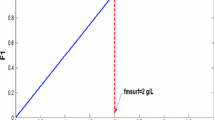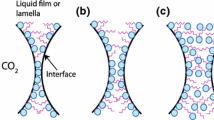Abstract
CO2 injection is one of the most promising techniques to enhance oil recovery. However, an unfavorable mobility ratio, reservoir heterogeneity and gravity segregation can reduce the macroscopic sweep efficiency. In situ foaming of injected CO2 is the method that has the most potential for improving sweep efficiency based on controlling CO2 mobility. This study investigates the foaming behavior of N,N,N′-trimethyl-N′-tallow-1,3-diaminopropane (DTTM) surfactant with CO2 in a transparent porous microflow model with natural rock pore structures. It focuses on the effect of the salinity induced non-Newtonian behavior of DTTM solution on foam propagation. The performance of foams stabilized by 0.5 wt% DTTM solution over the viscosity range from 0.71 (at 5 wt% NaCl) to 41 cp (at 20 wt% NaCl) was compared with conventional polymer-enhanced foams whose liquid phase contained a commonly used foaming surfactant, C15–18 Internal Olefin Sulfonate (C15–18 IOS) and a hydrolyzed polyacrylamide. Such comparisons have also provided insight into the respective impacts of liquid phase viscosification by worm-like surfactant micelles and polymer on foam texture associated with its rheological characteristics. It was found that at low aqueous phase viscosity (injection liquid viscosity of 0.71 cp) the maximum achievable viscosity of DDTM foam was around 1000 cp, which was 80 times IOS stabilized foam. The interfacial tension of DTTM was higher than that of IOS, resulting coarser foam texture and higher individual lamella resistance. An increase in DTTM solution viscosity by a factor of 33 decreased foam generation and viscosity for gas injection. This was not observed for the simultaneous injection of gas and DTTM solution. Overall, the effect of liquid phase viscosity on transient foam behavior during gas injection is similar for both DTTM and IOS regardless of the difference in the nature of viscosifying agents (WLM vs 3330 s polymer). An increase in gas injection pressure without liquid injection delayed foam propagation and reduced the magnitude of foam viscosity. The results from this study indicated that DTTM surfactant is an important alternative to commercially available polymers that have been used to enhance foam performance in porous media. This particular surfactant type also overcomes several disadvantages of polymers such as limited temperature and salinity tolerance, shear degradation, and filtering in low permeability formations.











Similar content being viewed by others
References
Bergeron, V., Langevin, D., Asnacios, A.: Thin-film forces in foam films containing anionic polyelectrolyte and charged surfactants. Langmuir 12(6), 1550–1556 (1996)
Bird, R.B., Stewart, W.E., Lightfoot, E.N.: Transport Phenomena, Rev. 2 edn. Wiley, New York (2007)
Chen, W.R., Butler, P.D., Magid, L.J.: Incorporating intermicellar interactions in the fitting of SANS data from cationic wormlike micelles. Langmuir 22(15), 6539–6548 (2006)
Dreiss, C.A.: Wormlike micelles: where do we stand? Recent developments, linear rheology and scattering techniques. Soft Matter 3(8), 956–970 (2007)
Graessley, W.W.: Viscosity of entangling polydisperse polymers. J. Chem. Phys. 47(6), 1942–1953 (1967)
Hirasaki, G.J., Pope, G.A.: Analysis of factors influencing mobility and adsorption in the flow of polymer solution through porous media. SPE J. 14(04), 337–346 (1974)
Huang, D.D., Nikolov, A., Wasan, D.T.: Foams: basic properties with application to porous media. Langmuir 2(5), 672–677 (1986)
Israelachvili, J.N., Mitchell, D.J., Ninham, B.W.: Theory of self-assembly of hydrocarbon amphiphiles into micelles and bilayers. J. Chem. Soc. Faraday Trans. 2(72), 1525–1568 (1976)
Klitzing, R.V., Espert, A., Colin, A., Langevin, D.: Comparison of different polymer-like structures in the confined geometry of foam films. Colloids Surf. A 176(1), 109–116 (2001)
Kumar, S., Awang, M. B., Abbas, G., Ahmed, S.: Wormlike micelles as a substitute of polymeric mobility control agent: rheological comparison. Presented at the Offshore Technology Conference-Asia (2014)
Kutay, S.M., Schramm, L.L.: Structure/performance relationships for surfactant and polymer stabilized foams in porous media. J. Can. Pet. Technol. 43(02), 19–28 (2004)
Le, V.Q., Nguyen, Q.P., Sanders, A.: A novel foam concept with CO2 dissolved surfactants. SPE-113370-MS (2008)
Li, R.F., Yan, W., Liu, S., Hirasuki, G., Miller, C.A.: Foam mobility control for surfactant enhanced oil recovery. SPE J. 15(04), 928–942 (2010)
Liebum, M.M., Hirasaki, G., Nguyen, Q.P.: Solubility of alkyl amine surfactants in mixed gas and pure CO2 environments. Ind. Chem. Eng. Res. 56(39), 10958–10964 (2017)
Liebum, M.M., Hirasaki, G., Nguyen, Q.P.: A systematic rheological study of alkyl amine surfactants for fluid mobility control in hydrocarbon reservoirs. Petrol. Sci. 15(3), 538–551 (2018)
Liebum, M.: Characterization of an Alkyl Diamine Surfactant for Gas Mobility Control in Gas Enhanced Oil Recovery and Conformance Control. The University of Texas at Austin, Austin (2016)
Magid, L.J.: The surfactant—polyelectrolyte analogy. J. Phys. Chem. B. 102(21), 4064–4074 (1998)
Mukherjee, J., Nguyen, Q. P., Scherlin, J., Vanderwal, P., Rozowski, P.: CO2 foam pilot in salt creek field, Natrona County, WY: Phase III: analysis of pilot performance. SPE-179635-MS (2016)
Marangoni, C.: Sull’espansione delle goccie d’un liquido galleggianti sulla superficie di altro liquido (On the expansion of a droplet of a liquid floating on the surface of another liquid). fratelli Fusi (Fusi brothers), Pavia, Italy (1869)
Nguyen, Q.P., Currie, P.K., Buijse, M., Zitha, P.L.J.: Mapping of foam mobility in porous media. J. Petrol. Sci. Eng. 58(1–2), 119–132 (2007)
Nguyen, Q.P., Currie, P.K., Zitha, P.L.J.: Motion of foam films in diverging-converging channels. J. Colloid Interface Sci. 271(2), 473–484 (2004)
Patist, A., Jha, B.K., Oh, S.G., Shah, D.O.: Importance of micellar relaxation time on detergent properties. J. Surfactants Deterg. 2(3), 317–324 (1999)
Petkova, R., Tcholakova, S., Denkov, N.D.: Foaming and foam stability for mixed polymer–surfactant solutions: effects of surfactant type and polymer charge. Langmuir 28(11), 4996–5009 (2012)
Ren, G., Zhang, H., Nguyen, Q.P.: Effect of surfactant partitioning on mobility control during CO2 flooding. SPE J. 18(4), 752–765 (2013)
Ren, G., Sanders, A.W., Nguyen, Q.P.: New method for the determination of surfactant solubility and partitioning between CO2 and brine. J. Supercrit. Fluids 91, 77–83 (2014)
Ren, G., Nguyen, Q.P.: Understanding aqueous foam with novel CO2-soluble surfactants for controlling CO2 vertical sweep in sandstone reservoirs. Pet. Sci. 14(2), 330–361 (2017)
Rossen, W.R.: A critical review of roof snap-off as a mechanism of steady-state lamella creation in homogeneous porous media. Colloids Surf. A Physicochem. Eng. Aspects 225, 1–24 (2003)
Rossen, W.R.: Minimum pressure gradient for foam flow in porous media: effect if interactions with stationary lamellae. J. Colloid Interface Sci. 139(2), 457–468 (1990)
Sanders, A., Jones, R.M., Rabie, A., Putra, E., Linroth, M.A., Nguyen, Q.P.: Implementation of a CO2 foam pilot study in the SACROC field: performance evaluation. SPE-160016-MS (2012)
Schramm, L.L., Wassmuth, F.: Foams: basic principles. In: Schramm, L.L. (ed.) Foams: Fundamentals and Applications in the Petroleum Industry, vol. 242, pp. 3–45. American Chemical Society, Calgary (1994)
Stubenrauch, C., von Klitzing, R.: Disjoining pressure in thin liquid foam and emulsion films—new concepts and perspectives. J. Phys. Condens. Matter 15(27), R1197 (2003)
Sydansk, R.D.: Polymer-enhanced foams part 1: laboratory development and evaluation. SPE Adv. Technol. Ser. 2(02), 150–159 (1994)
Talebian, S.H., Masoudi, R., Tan, I.M., Zitha, P.L.J.: Foam assisted CO2-EOR: a review of concept, challenges, and future prospects. J. Petrol. Sci. Eng. 120, 202–215 (2014)
Wreath, D. G.: A study of polymer flooding and residual oil saturation. Thesis, The University of Texas. (1989)
Acknowledgement
This study was supported by Gas EOR Consortium the University of Texas at Austin and the University of Texas at Austin.
Author information
Authors and Affiliations
Corresponding author
Rights and permissions
About this article
Cite this article
Ramadhan, G.B., Nguyen, Q.P. A Pore Scale Study of Non-Newtonian Effect on Foam Propagation in Porous Media. Transp Porous Med 131, 175–192 (2020). https://doi.org/10.1007/s11242-018-1159-2
Received:
Accepted:
Published:
Issue Date:
DOI: https://doi.org/10.1007/s11242-018-1159-2




